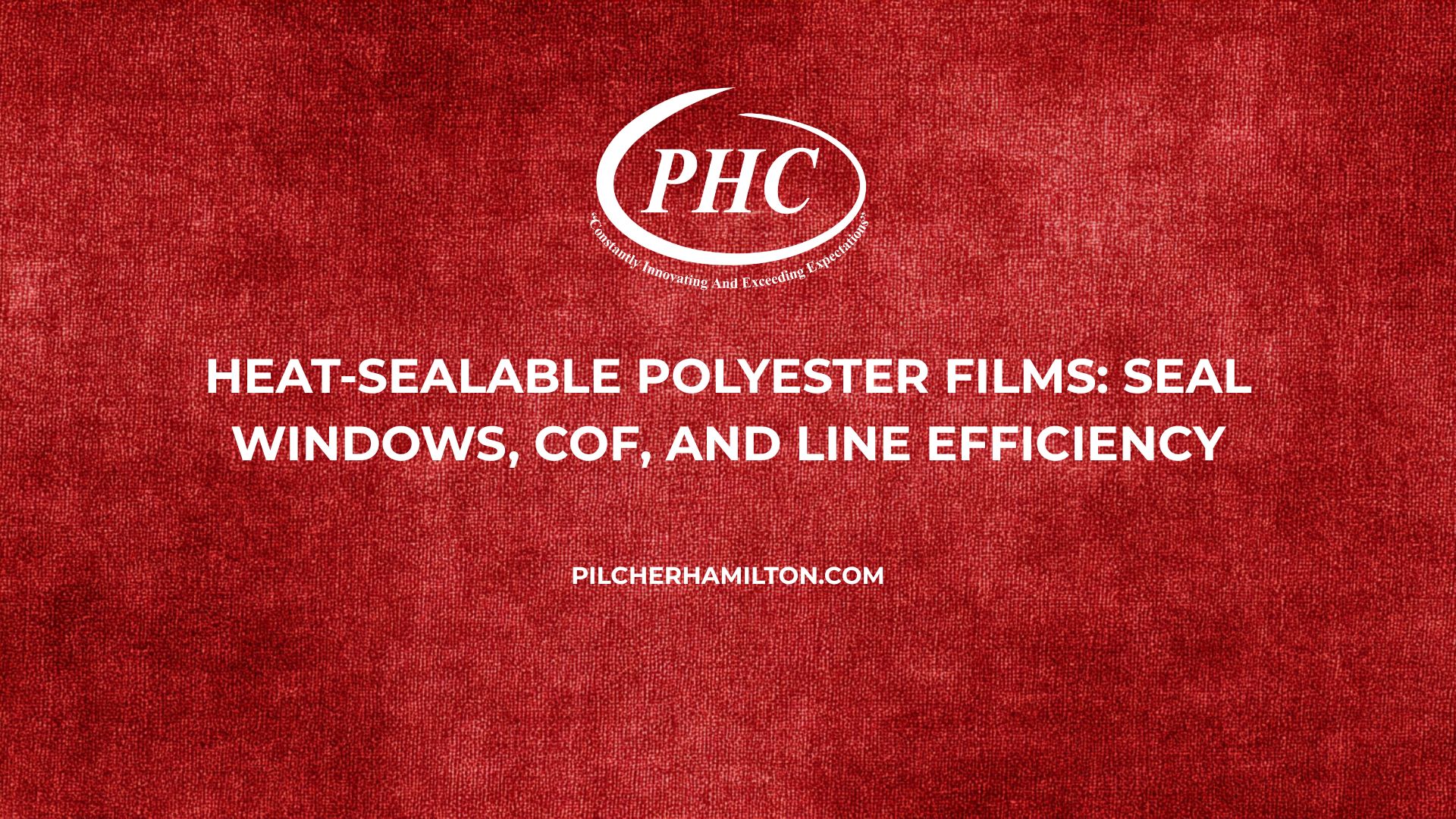Processors searching “polyester near me” for lidding and flow‑wrap applications know that not all PET films are heat‑sealable. Standard BOPET requires lamination to a sealable layer, but heat‑sealable PET incorporates a coextruded amorphous layer or coated sealant that melts at lower temperatures. These films deliver strong, tamper‑evident seals while preserving clarity and barrier performance. This article outlines seal windows, coefficient of friction (COF) control and practical tips for line efficiency when using heat‑sealable polyester films.
Key Takeaways
- Seal initiation temperatures – Seal layers begin to melt around 220 °F (104 °C) and reach full seal strength by 300 °F (149 °C).
- Wide seal windows – Heat‑sealable PET offers broad temperature ranges, accommodating variation in hot bars and dwell times.
- COF control – Slippery surfaces enable high line speeds; tailored COF values prevent jams and ensure consistent sealing.
- Hot tack strength – Sealant layers maintain integrity under load immediately after sealing, critical for form‑fill‑seal lines.
- Versatile applications – Ideal for lidding films, flow wrap, pouches and tray covers; available in clear, white and metallized versions.
Why PET for Sealable Structures
PET provides strength, clarity and barrier performance. Heat‑sealable grades add a sealant layer that melts at lower temperatures while the core PET maintains dimensional stability. The result is a film with high tensile strength and impact resistance, enabling thin gauges without compromising protection. PET’s inherent barrier can be enhanced with coatings or metallization for moisture and oxygen sensitive products.
Typical Seal Initiation Temperatures
Seal initiation refers to the temperature at which the seal layer begins to soften and bond. Heat‑sealable PET typically initiates at 220–240 °F (104–116 °C) and achieves full seal strength around 280–300 °F (138–149 °C). Seal strength depends on dwell time and pressure; longer dwell times allow lower temperatures. Hot tack—the ability of the seal to hold before it cools—is important on vertical form‑fill‑seal lines, where pouches drop immediately after sealing.
COF Ranges & Slip Control
COF influences how film unwinds and runs on high‑speed packaging lines. Heat‑sealable PET can be engineered with low‑slip (COF 0.2–0.3) for flow wrap or higher COF (0.3–0.5) for lidding films. Too low COF may cause telescoping or misregistration; too high COF can stall film feed. Slip agents are incorporated into the sealant layer, and surface treatments adjust friction. When designing a structure, balance COF with seal initiation temperature and barrier needs.
Lidding vs Flow‑Wrap Builds
Lidding films seal to trays made of PET, APET, CPET or PP. Sealant chemistry must be compatible with the tray substrate. For example, PET/PE lidding films seal to PE-coated trays; PET/sealant PET structures seal to APET trays. Flow‑wrap applications use monolayer or laminated films designed for backfin sealing; high hot tack ensures seals hold under tension. For modified atmosphere packaging (MAP), barrier coatings such as PVDC or EVOH are added.
QA: Seal Strength & Hot Tack
Seal strength is measured by peel tests and typically ranges from 2–5 lbs/in for easy‑open lidding to >10 lbs/in for hermetic seals. Hot tack strength should remain above 0.5 lbs/in immediately after sealing. PHC’s quality control verifies seal strength across a temperature range and reports COF values; technical datasheets provide guidance on optimal seal conditions.
| Parameter | Typical Range | Notes |
| Seal initiation temperature | 220–240 °F (104–116 °C) | Start of melting for seal layer |
| Seal window | 220–300 °F (104–149 °C) | Temperatures producing strong seals |
| COF (slip) | 0.2–0.5 | Adjusted for flow wrap or lidding |
| Hot tack strength | >0.5 lbs/in | Immediate seal strength after heating |
| Thickness | 48–120 ga | Higher gauges for lidding films |
FAQ
Do I need special equipment to seal PET film? Heat‑sealable PET works with standard heat bar or impulse sealing equipment. Ensure bar temperatures and dwell times fall within the recommended seal window.
Can heat‑sealable PET be used for retort pouches? Standard heat‑sealable PET is not designed for retort conditions. For high‑temperature processing, use retortable PET/CPP laminates or BON/PET structures.
How do I choose the right COF? Consider the packaging line speed and product weight. Low‑COF films enable high speeds but may slip; moderate COF provides control. Testing on production lines is recommended.
What barrier options are available? Heat‑sealable PET can be coated with PVDC or metallized to improve oxygen and moisture barrier. Gauge and coating selection depend on product shelf‑life requirements.
Where can I find polyester near me for heat‑seal applications? PHC’s Greer location stocks heat‑sealable PET films and offers slitting and sheeting for lidding and flow‑wrap operations.
Call to Action
Improve sealing reliability and line efficiency with heat‑sealable PET films from Pilcher Hamilton Corporation. Our specialists can recommend seal layers and COF levels tailored to your product and equipment. Explore our heat‑sealable films and packaging lineup pages for details, or contact us via our locations for a personalized consultation. Let your search for polyester near me end with PHC’s responsive service.
Serving the USA from Greer – South carolina
850 South Buncombe Road
Greer – South carolina
Visit our contact page or see our locations to get started.

